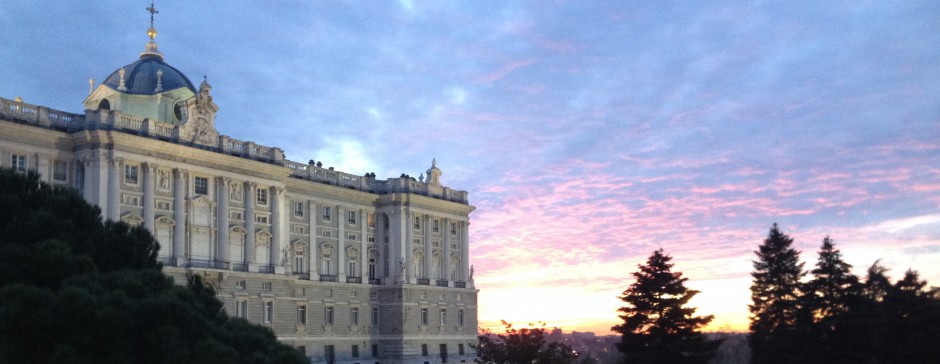The busy Madrid-filled week continued with an adventure with Christy on Tuesday and a paseo with Kike on Wednesday.
Like most Tuesdays, Christy and I had a bit of free time that we wanted to take advantage of to explore the city a little bit more. We stuck around Moncloa again, because it’s near ICADE where she had a class earlier and I had one later that afternoon. The district of Moncloa is in the northwest part of the city and includes Casa de Campo, the campus of the Universidad Complutense in Ciudad Universitaria (University City), and the official residence of Spain’s prime minister at the Palacio de Moncloa. We met at the Arco de la Victoria, which was actually built by Franco to commemorate his winning the Civil War, and then headed to the Museo de América. We wanted to go the Faro de Moncloa as well, a large tower that apparently gives good views of the city and whose name means “lighthouse,” but it’s been closed for years due to construction. 🙁
The Museum of the Americas holds thousands of pieces from the Americas, ranging from artistic pieces to archaeological artifacts and from the prehistorical period to today. It was cool to see a bunch of examples of the history of Americas and it reminded us of home, and the best part was that it’s free for university students. There was a huge variety of collections, plus we were glad to get an escape from the sun and warm weather. However, with all those pieces on only two floors, we quickly got our fill after walking around and seeing the highlights, so we headed to local Tierra Burrito, Madrid’s Chipotle-like restaurant, to eat outside before I had to head to class.
Our adventure with Kike, the Paseos por Madrid teacher, on Wednesday evening would prove to be even more fun though. We met at the Legazpi Metro Station and headed to the Matadero, a former Neo-Mudéjar slaughterhouse that has since been turned into an art exhibition space. Located right on the Manzanares River that flows through Madrid, the slaughterhouse was used for 85 years until 1996 and provided a large amount of Madrid’s meat products, especially with the easy distribution given by its river location. It’s crazy to think that the with tons of cool exhibits there today, both temporary and permanent, the building complex was used to kill millions of animals over almost a century, especially since some of the rooms were kept in the style of a slaughterhouse with doorways covered by long plastic strips… but it was still cool, even if a little creepy.
This week’s paseo was definitely more like a traditional paseo in the true sense of the word though. A paseo is basically a promenade, or a leisurely stroll through town, and this definitely qualified as that. We followed the Manzanares river for at least 5 kilometers, passing by lots of beautiful parks and the Vicente Calderón Stadium, until we got to the Puente de Segovia near the Royal Palace and almost to Príncipe Pío. It turns out that the river used to be pretty ignored by the madrileños and became polluted by Madrid’s main circular highway, but then the M-30 road was moved underground and the nearby river area was restored. Many cool parks were built for children and there’s a great running and walking path, improvements which the Ayuntamiento hopes will turn Madrid into a city that identifies a little more with its river and utilizes it, even if not to the extreme of Paris’s Seine. Though its more of a laid-back and residential area towards the south of the city, we definitely want to go back there once it gets warmer just to enjoy it.
One of the coolest parts about this walking tour, other than the beautiful parks, nice warm weather, and cool Matadero space, was being able to explore a new part of Madrid we haven’t seen before. As I’m sure you can tell, we’re definitely trying to take advantage of the city we call home and get to know all of it, not just the areas we spend a lot of time in. But more than just visiting the different areas, we also like to get to know them and how they all connect. Although some might not realize it if they take the Metro everywhere, Madrid is an incredibly walkable city and most of the main spots are very close together. We try to walk places as much as we can to make sure that we realize how all the puzzle pieces fit together, but we hadn’t walked around the south edge of the city like this before. When we figured out how places we’d been too so often — Sol, La Latina, Pirámides (home to the Atleti stadium), Ópera/Royal Palace, and Príncipe Pío — all fit together, our minds were blown a little bit. We hadn’t really seen them from that angle, so we had missed out on those connections, but now our mental maps are that much more developed. This reminded us yet again how awesome these paseos are because they’re meant to do just that: get us to experience things we wouldn’t normally and see the city in a different way.


